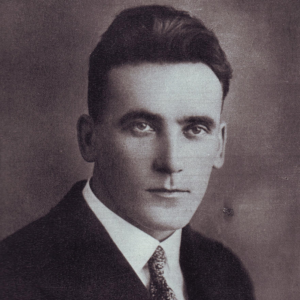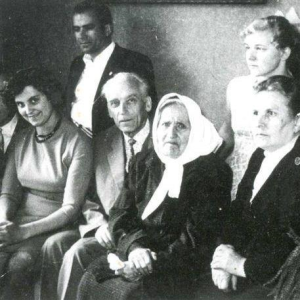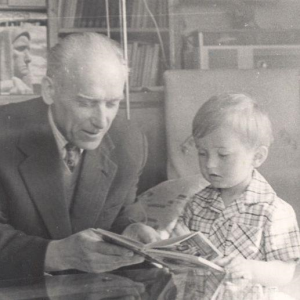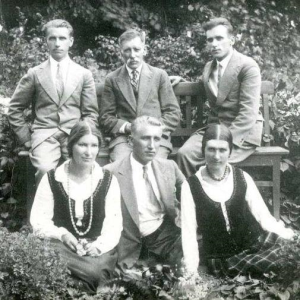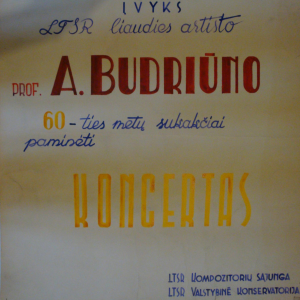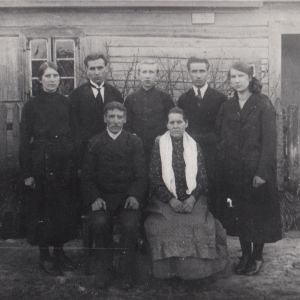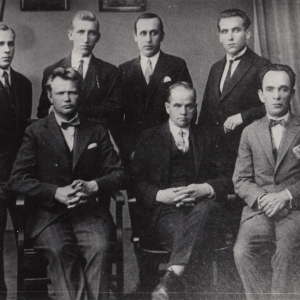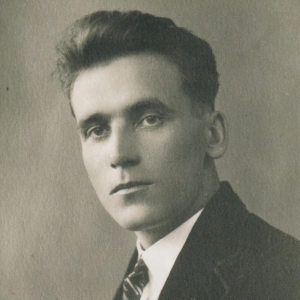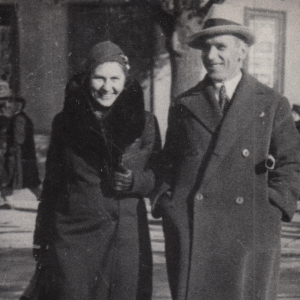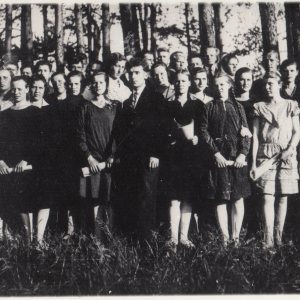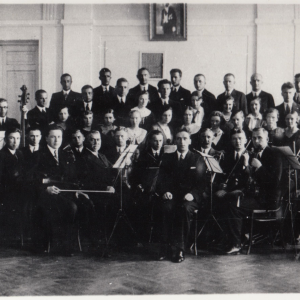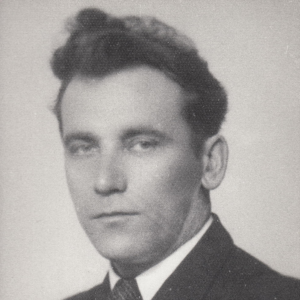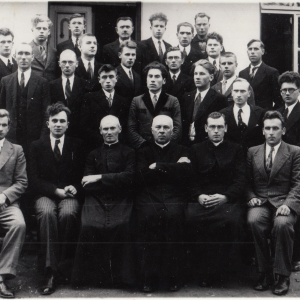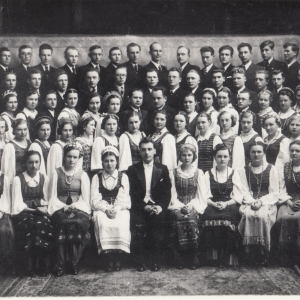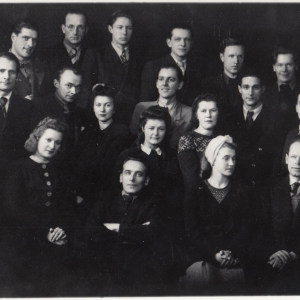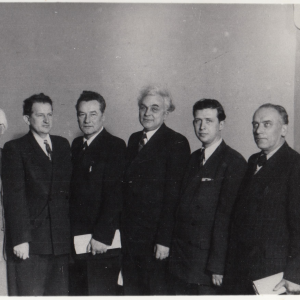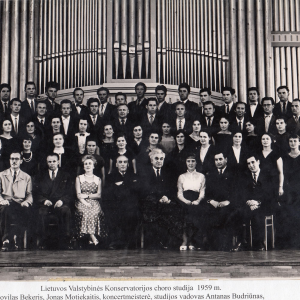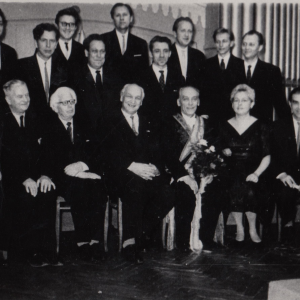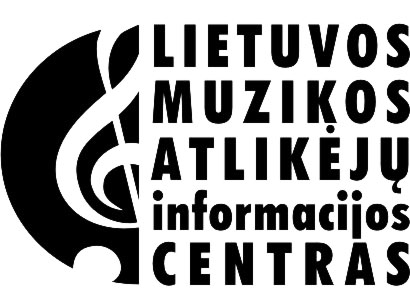
Antanas Budriūnas (1902-1966)

Antanas Budriūnas (born on 20 September 1902 in Pabiržė, Biržai district – died on 5 October 1966 in Vilnius) was a Lithuanian organist, a composer, a choir conductor and a pedagogue
Antanas Budriūnas was born on 20 September 1902 in Pabiržė, Biržai district. In his childhood Antanas constantly heard music at home – his father Motiejus and mother Salomėja Kruopytė sang in a church choir, May services were held in their house, hymns and folk songs were sung by the family choir, which the eldest brother Motiejus formed.
Antanas attended a secret school of Daudžgiriai manor, and he was taught to play music by the local organist. At the age of 17 (1919–1921) Antanas Budriūnas played the organ already and conducted amateur choirs in Pabiržė and Smilgiai (Biržai district). Between 1922 and 1938, Antanas Budriūnas attended Kaunas Music School and at Kaunas Conservatory attended classes of Aleksandras Kutkus (vocal performance), Lidija Dauguvietytė and Balys Dvarionas (the piano), Juozas Gruodis (composition), Julius Štarka and Nikodemas Martinonis (choral conducting). He attended music school (later studied at the Conservatory) with intervals, graduated from the composition and choral conducting classes. While a student he became actively engaged in the cultural life of Kaunas, conducted choirs, worked as a pedagogue. In 1928, he was called up in military service in Kaunas where he conducted the soldiers’ choir, played the organ at the Church of St. Michael the Archangel (Įgulos) in Kaunas. Between 1926 and 1937, while continuing his studies, he was a music instructor and choral conductor of Dotnuva Agricultural Academy.
Having begun an intensive cultural and creative activity early in his life, Antanas Budriūnas left a weighty and significant legacy.
The activities of a composer, a choral conductor and a pedagogue are closely intertwined in Antanas Budriūnas’ creative work. He is one of the famous composers of the older generation who was related to choirs and their activities throughout his all life. Therefore choral and vocal music form the largest part of Antanas Budriūnas’ creative work. He composed original songs, harmonised folk songs adapting them to choirs that he himself conducted. He created more than 70 original and harmonised more than 20 folk songs of different composition for adults’ and children’s choirs, composed about 20 songs for solo and duet. He wrote compositions of a larger form too: they are three cantatas, the symphonic poem Vizijos ant piliakalnio (Visions on the Hill-fort), two string quartets, a Piano Sonata, Scherzo, folk dances and songs for the piano.
Today the composer’s music is still alive: his compositions are performed by choirs, at song festivals, are enjoyed and performed by the ensembles of Lithuanian Diasporas.
Antanas Budriūnas is noted for his pedagogical activity too. He started working as a pedagogue at Kaunas secondary schools in 1927, at Dotnuva Agricultural Academy (1926–1937), and continued his teaching work till the end of his life. Between 1937 and 1942, he taught music at Kaunas High schools, in 1940–1942, worked at Kaunas Conservatory, in 1940-1941 was Deputy Director for Academic Affairs. Between 1942 and 1948, Budriūnas taught at Dotnuva Agricultural Academy, was a mixed choral and orchestra conductor, an organist. He taught the student choir (60 participants) about 40 songs and put on 18 concerts, won the third place in the competition of the National Song Festival of 1946. From 1946 to 1949, Antanas Budriūnas was a lecturer at Kaunas Conservatory, from 1949 until his death he was a lecturer at the Conservatory of the Lithuanian SSR in Vilnius. In 1949–1950, he was Dean of the Solo Singing and Choral Conducting Faculty, a long-time Head of the choral studio and a lecturer of conducting. From 1951, he was an Associate Professor and in 1965 he was awarded a professorship. In 1957–1959, Antanas Budriūnas also taught at the Department of Music of Vilnius Pedagogical Institute.
Antanas Budriūnas was a talented pedagogue respected and loved by his students. He trained many choral conductors at the higher educational institutions. One of the most renowned pupils of Antanas Budriūnas is conductor Jonas Aleksa (1939–2005). In 1961, Antanas Budriūnas founded a national mixed choir of music teachers and was its art director and chief conductor. The choir helped music teachers of many Lithuanian schools to improve their qualifications, gave concerts in many cities and towns of Lithuania.
Antanas Budriūnas was an active member of the public cultural life of Lithuania. In 1931, together with his brothers Motiejus (1898–1969) and Bronius (1909–1994), he started issuing the magazine Muzikos barai (in 1931–1933 financed its publication), was a member of the Editorial Commission, wrote a great number of articles on the history of music, propagation of choral art, methods of teaching music and other themes. Budriūnas took an active part in the work of the Lithuanian Musicians’ Union, was a member of its Board, a Second Secretary and a Treasurer, an instructor on wind orchestras. In 1932, he initiated the first typographic printing of notes in Lithuania in Movšovičius printing house in Kėdainiai.
Antanas Budriūnas was a conductor at song festivals of different organisations in interwar Lithuania, a consultant on the National song festivals of the post-war years and one of the leading authorities on the choral art issues. He was a member of the Council of Choral Directors of the city of Vilnius and a conductor of song festivals, the initiator, art director and chief conductor of the First National Schoolchildren’s Song Festival held in 1964, a chairman or a member of the jury of choir reviews and competitions, a Chairman of the State Examination Commissions, a member of the Lithuanian Composers’ Union (as of 1947), later he was the Board member (1962–1965). Antanas Budriūnas was a member of the Commission on the Repertoire of the 1965 National Song Festival, a member of the Art Council of the National Trade Union Palace, a member of the Choral Art Council of the Lithuanian National Philharmonic Society. He delivered lectures on the themes of music in Kaunas, Vilnius, Šiauliai, Panevėžys, Klaipėda. He wrote articles and review papers. While a lecturer at Dotnuva Agricultural Academy he prepared Muzikos istorija [History of Music], the first in Lithuania, which was periodically published in the magazine Muzikos barai (1931–1933). He contributed greatly to musical education of the youth by preparing pedagogical literature. Antanas Budriūnas wrote Muzikos vadovėlis VIII klasei [Music Textbook for the 8th Form]. .
In 1955, Antanas Budriūnas was awarded an honorary tile of the Merited Artist, and in 1962 he was granted the title of the National Artist of the Republic of Lithuania.
Antanas Budriūnas died on 5 October 1966 in Vilnius, is buried in Antakalnis Cemetery. At the present time in Pabiržė (Biržai district), in the house located at 2 Ramioji Str. where the composer was born and in the flat in Antakalnis in Vilnius (at 8-1 Kuosų Str.) where Antanas Budriūnas lived from 1958 to 1966 his son Algimantas established a museum.
Prepared by Aldona Juodelienė
Sources:
Dumbliauskaitė Lina. Muzikai broliai Budriūnai: gyvenimo vingiai, kūryba, kultūrinė visuomeninė veikla. Vilnius, 2011.
Zubrickas Boleslovas. Pasaulio lietuvių chorvedžiai: enciklopedinis žinynas. Vilnius, 1999.
Tauragis Adeodatas. Budriūnas Antanas . Muzikos enciklopedija, T. I. Vilnius: Mokslo ir enciklopedijų leidybos institutas, 2000, p. 211.
Antanas Budriūnas. Lietuvos muzikos informacijos centras. Prieiga per internetą: http://www.mic.lt/lt/baze/klasikine-siuolaikine/kompozitoriai/budriunasantanas/#works-000A [žiūrėta 2019 birželio 3 d.]
Antanas Budriūnas. Vikipedija. Prieiga per internetą: https://lt.wikipedia.org/wiki/Antanas_Budriūnas [žiūrėta 2019 balandžio 3 d.]
